![]()
![]()
![]()
Use LEFT and RIGHT arrow keys to navigate between flashcards;
Use UP and DOWN arrow keys to flip the card;
H to show hint;
A reads text to speech;
69 Cards in this Set
- Front
- Back
- 3rd side (hint)
|
Metabolism
|
The rate at which we generate heat. It changes with level of activity, when and what we eat, and where we are in our daily cycle.
Measured in met = 18.4 Btu/h ft^2. 1 met of energy per unit of surface area (of a seated person) = 360 Btu/h or 106 watts. Heat dissipates into the environment to keep us health and comfortable. Age, weight, gender impact metabolic rate |
2.1 The Body
|
|
|
What is hypothalamus?
|
Our internal thermostats.
Touch, blood, and water are signals for a change in heat regulation. It causes a change in our blood distribution system in response to signals from our skin to core temparatures |
|
|
|
Hypothalamus:
Vasoconstriction |
Occurs in COLD CONDITIONS
A decrease in blood flow to the skin. Caused by cold signals. The sweat glands produce and send less water to the skin, thus causing a reduction in evaporation and heat loss. The farther away from our central body mass the greater the surface area; the faster that body part gets cold. |
|
|
|
Hypothalamus:
Skin Surface |
Is the most variable thermal zone.
|
|
|
|
Hypothalamus:
Vasodilatation |
Occurs in HOT CONDITIONS.
An increase in blood flow to the skin. Caused by warm signals. More water is generated by the sweat glands, thus causing increased evaporation and heat loss |
|
|
|
From MEEB (10th)
The three phases of the design process are generally known as |
A. Concept design, schematic design, and design development
B. Scheming, conceptual design, and benchmarking C. Value scaling, stability benchmarking, and design development. D. Conceptual design, value scaling, and regenerative design Answer: A |
|
|
|
Although plans can and do change during all phases of the design process, to ensure a smooth process, fundamental decisions about the building should be made during the:
|
A. Design development phase
B. Construction phase C. Conceptual design phase D. Occupancy phase Answer: C |
|
|
|
Which of the following is an example of design intent?
|
A. The building will score a 0 on Malcom Wells' Architectural Value Scale.
B. The lighting system power density will be no greater than 0.9W/ft^2. C. The building will be green, with a focus on indoor environmental quality. D. The building will achieve a Platinum KEED rating Answer: C |
|
|
|
Which of the following is an example of design criteria?
|
A. No building space will experience more than 1,000 ppm CO2.
B. The building will use primarily passive systems. C. The building will provide outstanding comfort for its occupants. D. The building will be aesthetically pleasing. Answer: A |
|
|
|
Which of the following building requirements are written in prescriptive language?
|
A. A public building must maintain a temperature of at least 68 degree F (20 degrees C) during all seasons.
B. A building shall be able to resist wind speeds of up to 100 mph (161 km/h). C. A building shall be able to safely drain rain falling at a rate of 2 in./h (50.8 mm/h). D. Pipe in a roof drainage system shall measure no less than 3 in. (7.63 cm) in diameter. Answer: D |
|
|
|
Which of the following entities is most likely to generate building design standards?
|
A. The City of San Francisco.
B. The American Federation of Labor - Congress of Industrial Organizations. C. The American Society of Heating, Refrigeration and Air-Conditioning Engineers. D. The International Code Council. Answer: C |
|
|
|
The term "energy efficiency" in architecture can best be described as:
|
A. Conserving energy as well as balancing outputs and inputs.
B. Minimizing depletion of renewable energy resources. C. The degree to which a building project complies with codes. D. The ratio of HVAC system outpur to HVAC system input. Answer: D (no, A) |
|
|
|
Which of the following maxims reflect an overall design philosophy that encompasses the concept of sustainability?
|
A. Consider nature as both model and context.
B. Use only the finest materials for building longetivy. C. Use only structural insulated panels (SIPs) for insulation and enclosure. D. Maintain a constant temperature of 72 degrees F (22.2 degrees C) within the building envelope. Answer: B (no, A) |
|
|
|
Which of the following building features embody the design philosophy "manage storage"?
|
A. Ample closet space.
B. Cisterns that capture rainwater for re-use within the building. C. A separate conditioned space for heat-producing computers. D. A large, multi-vehicle garage. Answer: B |
|
|
|
Which of the following characteristics best exemplify a passive climate control system?
|
A. The system uses no energy.
B. The system uses built-in electric space heaters. C. The system/building components play multiple roles. D. Mechanical cooling is used with solar heating. Answer: C |
|
|
|
PSYCHOMETRIC CHART
What are the three basic definitions used to describe various air conditions? |
1. Atmospheric Air
2. Dry Air 3. Moist Air |
|
|
|
What is Atmmospheric Air?
|
Air that contains nitrogen, oxygen, carbon dioxide, water vapor, dust, pollen, smoke, etc. Bascially, the air we breath and use for ventialtion.
|
|
|
|
What is Dry Air?
|
Air when contaminants (smoke, pollen, dust) and water vapor has been removed from Atmospheric Air.
It contains 78% nitrogen, 21% oxygen, and 1% other gases. It is used as a reference in Psychrometrics. |
|
|
|
What is Moist Air?
|
Air that is a mixture of Dry Air and water vapor.
|
|
|
|
The Psychrometric Chart
|
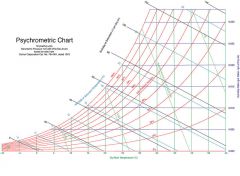
The relationship between Dry Bulb (enthalphy), Wet Bulb, Relative Humidity, and Humidity Ratio
|
|
|
|
What is Dry Bulb Temperature?
|
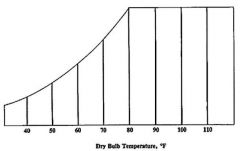
1. It is the temperature determined by a thermometer.
2. The temperature given in weather reports. 3. Dry bulb temperature scale is located at the base of the chart by vertical lines. The vertical lines indicate constant dry bulb temperature. |
|
|
|
What is Wet Bulb Temperature?
|
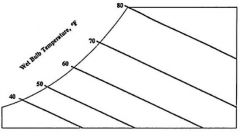
It indicates the cooling effect of evaporating water.
It is determined by passing air over a thermometer that has been wrapped with a moist cloth. The evaporating water causes a cooling effect and lowers the temperature compared to the dry bulb air temperature. Wet bulb temperature scale is located along the curved upper part of the chart; it's lines slope from left to right and denote equal wet bulb temperature. |
|
|
|
What is Dew Point Temperature?
|

It is the temperature below where moisture will condense out of air.
The temperature at which the water vapor in the air becomes saturated and condensation begins. |
|
|
|
How does Dew Point Temperature effect human comfort?
|
Humans tend to react with discomfort to a high dew point (i.e. greater than 59 °F), as it interferes with the body's normal process of perspiring (producing sweat) to cool down. High relative humidity (which results in a high dew point) impedes the evaporation of sweat and reduces the effectiveness of evaporative cooling. As a result the body may overheat, resulting in discomfort.
Lower dew points, less than 10 °C (50 °F), correlate with lower ambient temperatures and the body requires less cooling. A lower dew point can go along with a high temperature only at extremely low relative humidity, allowing for relative effective cooling |
|
|
|
What is Relative Humidity?
|
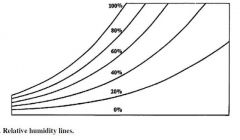
A measure of how much moisture (relationship with Dew Point) is present in regard to how much moisture the air COULD hold at that temperature.
Relative humidity is given in weather reports. It is stated as a percentage. The 100% relative humidity (saturation) line parallels to the wet bulb and the dew point temperature scale line. The 0% relative humidity line falls along the dry bulb temperature scale line. |
|
|
|
How do you read the psychometric chart?
|
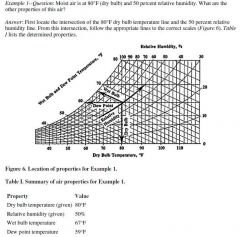
Other values can be determined on the psychometric chart if two properties of moist air are known.
|
|
|
|
Determine the temperature of walls to prevent condensation given an air dry bulb temperature of 80 degrees and a relative humidity of 70 degrees.
|
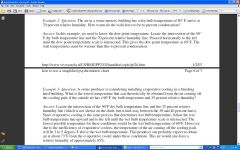
Example 2
|
|
|
|
What is the lowest temperature that can be obtained from air coming off a cooling pad given an air dry bulb temperature of 90 degree and a relative humidity of 35%?
|
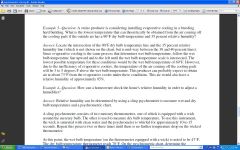
Example 3
|
|
|
|
How can one check relative humidity in order to adjust a humidifier?
|
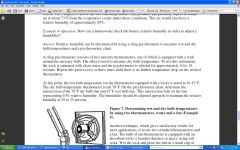
Example 4
|
|
|
|
Explain the sling psychrometer?
|
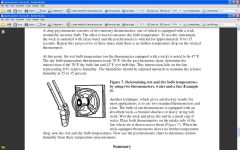
Sling Psychrometer image.
|
|
|
|
Determine the wall temperature required to prevent condensation given an air dry bulb temperature of 80 degrees and relative humidity of 70%
|

Example 2
|
|
|
|
What is the lowest temperature that can be obtained from air coming off a cooling pad given outside air temperature of 90 degrees and relative humidity of 35%?
|

Example 3
|
|
|
|
How can relative humidity be checked in order to adjust a humidifier?
|

Example 4
|
|
|
|
Explain the sling psychrometer
|
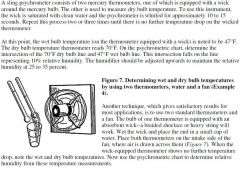
Sling Psychrometer figure
|
|
|
|
Heat Flow:
What is Heat Flow? |
Heat energy that moves from high concentration to low concentration.
Measured in Btu which is the energy required to raise 1 lb. of water to 1 degree (152 cal). |
|
|
|
Heat Flow:
What is CONDUCTION? |
1. The kinetic energy exchange of heat through touch.
2. Air is not a good conductor of heat energy. Energy is transferred through physical contact. 3. The molecular agitation within a material without any motion of the material as a whole. 4. Conduction is most effective in solids-but it can happen in fluids |
|
|
|
Heat Flow:
For heat transfer between two plane surfaces, such as heat loss through the wall of a house, what is the rate of Conduction Heat Transfer? |
Q = U x A x ∆T
Btus = u-value x area x temp. change This is the material's ability to conduct heat. |
|
|
|
Heat Flow:
What is CONVECTION? |
1. Heat transfer within a fluid medium: air, water
|
|
|
|
Heat Flow:
What is HEAT FLOW? |
Heat energy that moves from high concentration to low concentration in Btus.
The energy required to raise 1 pound of water to 1 degree F (152 cal). |
|
|
|
Heat Flow:
What is CONVECTION? |
Heat transfer within a fluid medium such as air or water.
Air movement - hot air rises and could air falls. Wall Surface Example: A film of air exchanges energy with air that gets caught on thw wall surface. Moving air can never get to the wall. Heat transfer happens slow because of the air film. The temperature of air and surface change (Δt) |
|
|
|
Heat Flow:
What is RADIATION? |
The transfer of heat thru ELECTROMAGNETIC WAVES (no molecules needed)
- Emittance: the ability of ajn object to emit radiation. - Absorbants: ability of an object to receive radiation. - Δt: temperature change. Relative size:???? |
|
|
|
Heat Flow:
What is EVAPORATION? |
A change of state of a substance
- LATENT HEAT: the energy embodied in water vapor. - As temperature reaches our body temp. (98.6 degress), conduction, convection, and radiation stop being heat transfer options and evaporation is the alternative; thus dry moving air is essential. When the temperature falls, evaporation lessens and conduction, convenction, and radiation start becoming heat transfer options and they increase. |
|
|
|
Clothing:
What is CLO? |
-The insulative value of clothing.
- Total clo of typical clothing is 0.15 clo per pound of clothing's weight. This number is higher in the winter and lower in the summer. |
|
|
|
Comfort:
What are the three comfort factors? |
1. Personal
2. Measureable environmental 3. Psychological Designer has the primary objective of heating and cooling people, and the building is the means to the end. |
|
|
|
Comfort:
Describe the Personal comfort factor. |
It's what you control: Metabolism, clothing, adaptation to environment such as migration to a comfortable place, drinking or eating warm or cold foods.
|
|
|
|
Comfort:
Describe the Measureable Environmental comfort factor. |
It is the primary aim of the building and controlled by the designer.
1. Air temperature: range of temps for a given activity 2. Surface temperature: radiation 3. Air motion: increases convection/conduction and rate of heat transfer 4. Humidity: controls the rate of evaporation |
|
|
|
Comfort:
Describe the Psychological comfort factor. |
Controlled by the designer:
1. Color 2. Texture 3. Sound 4. Light 5. Movement 6. Aroma |
|
|
|
Comfort:
Heat tranferred by Conduction (touch) |
Depends on surface temperature.
The opposite of Radiation. |
|
|
|
Comfort:
Heat transferred by Convection (molecules): |
Depends on air temperature, then air movement, then humidity.
The opposite of Evaporation. |
|
|
|
Comfort:
Heat transferred by Radiation (touch and orientation): |
Depends on surface temperature (and orientation to the body).
The opposite of Conduction. |
|
|
|
Comfort:
Heat transferred by Evaporation (humidity): |
Depends on humidity, then air motion, then air temperature.
The opposite of Convection. |
|
|
|
Comfort:
What is Mean Radiant Temperature (MRT)? |
The average surface temperature of a space's surfaces.
|
|
|
|
Comfort:
What is the "Comfort Zone"? |
The combinations of air temperature and relative humidity, with a clo of 0.6.
This zone can be expanded by adding more sun or more wind. In very dry climates, add more moisture to the air. Figure 2.4, pp. 42 |
|
|
|
Comfort:
What is Operative Temperature? |
The average temperature of a space's temperature and the MRT.
|
|
|
|
Comfort:
What is Acclimatizating? |
Modifying the body and mind to become more resistant to cold or heat stress. pp. 47
|
|
|
|
Comfort:
The body is thermally sensitive in the following places: |
Heat receptors: Finger tips, nose, elbows
Cold receptors: Upper lip, nose, chin, chest, and fingers |
|
|
|
Comfort:
What is Radiant Asymmetry? |
It is the difference between two opposite surfaces' temperatures.
|
|
|
|
Climate s:
What are the four climate zones? |
1. Cool (northern most USA and Canada)
2. Temperate (Central US, Mexico) 3. Hot-arid (Southwestern US) 4. Hot-humid (Southeastern US) |
|
|
|
Cooling Design Strategy:
What is Natural Ventilation Cooling? |
When higher air temperatures are offset by more air motion.
Typically used in humid, hot climates were day and night temperature changes are minimal. Design buildings to be open to winds and closed to direct sunlight. Buildings should be thermally lightweight since night air is not cool enough to remove built-up daytime heat. |
|
|
|
Cooling Design Strategy:
What are the two variations of Natural Ventilation? |
1. Cross ventilation: accomplished by using windows.
Design relies on narrow plan with large opening at either end. 2. Stack ventilation: utilizes low windows for intake and high windows for exhaust. Based on the principle that hot air rises. Stack ventilation is weaker than Cross ventilation. |
|
|
|
Cooling Design Strategy:
What is High-Mass Cooling? |
Used in warm-dry summer climates with hot days and still-cool nights.
Night temperature takes heat away from building mass. Themal mass is located on floors, walls, or roof but requires a "sink" to reject its heat by night. Two variations: 1. Roof ponds 2. Earth contact |
|
|
|
Cooling Design Strategy:
What are advantages to Roof Ponds? |
Roof ponds can radiate to the cold sky, but should be protect from direct sun during daytime.
They and be used for one or two story buildings. A massive roof allows for design freedom below and in walls and fenestration. |
|
|
|
Cooling Design Strategy:
Describe Earth Contact. |
When the earth acts as a heat sink, keeping walls and floors cool.
Best to allow contact in summer and isolate the earth from building in winter. |
|
|
|
Cooling Design Strategy:
Describe High-Mass Cooling w/Night Ventilation |
Used in hot-dry summer climates.
Uses cool air at nighttime temparatures to flush away stored daytime heat. Uses fans to ventilate quickly since nighttime hours are fewer than daytime. Building transitions from thermally closed by day to thermally open at night. Nighttime temperatures must be below the comfort zone for this stategy to work. |
|
|
|
Cooling Design Strategy:
What is Evaporative Cooling? |
When moisture is added to air, the air increases in relative humidity while decreasing in dry-bulb temperature.
Uses HVAC equipment. Creates high indoor air velocities and noise. Building smells of wet material. Creates cool air at the inlet and warm air at the outlet. |
|
|
|
Heating Design Strategy:
Name the three solar heating strategies. |
1. Direct Gain (DG): allowing sunlight and heat into the space so it warms thermal masses.
2. Indirect gain (TW-Trombe Wall): sun hits thermal first, then passes as heat to the space behind. 3. Isolated gain (SS-sun space): when a sun space or green house is heated day and some of the heat is released into an adjacent space. |
|
|
|
Heating Design Strategy:
Direct Gain application. |
1. Requires mass to be minimum 4" thick.
2. Best used in building with southern glass facade. 3. Popular because of its simplicity, ample daylight and southern view. 4. Glare is a problem, causes overheating on sunny days, and large radiant heat losses thtuogh glass at night. This results in large diurnal diffenence in interior temperature. 5. Best for winter heating and is similar to night ventilation of mass. |
|
|
|
Heating Design Strategy:
Indirect Gain application. |
1. A Trombe wall in front of a window has made this the least used strategy.
2. Doesn't admit much daylight and the wall blocks views. 3. It allows less glare, less overheating on sunny days, and not fading of furniture in direct sunlight. 4. Provides large radiant heat in the evenings. |
|
|
|
Heating Design Strategy:
Isolated Gain application. |
1. More popular since it provides a sunny inhabitable space, has broad daily temperature variations which makes the adjacent space pleasant.
|
|

